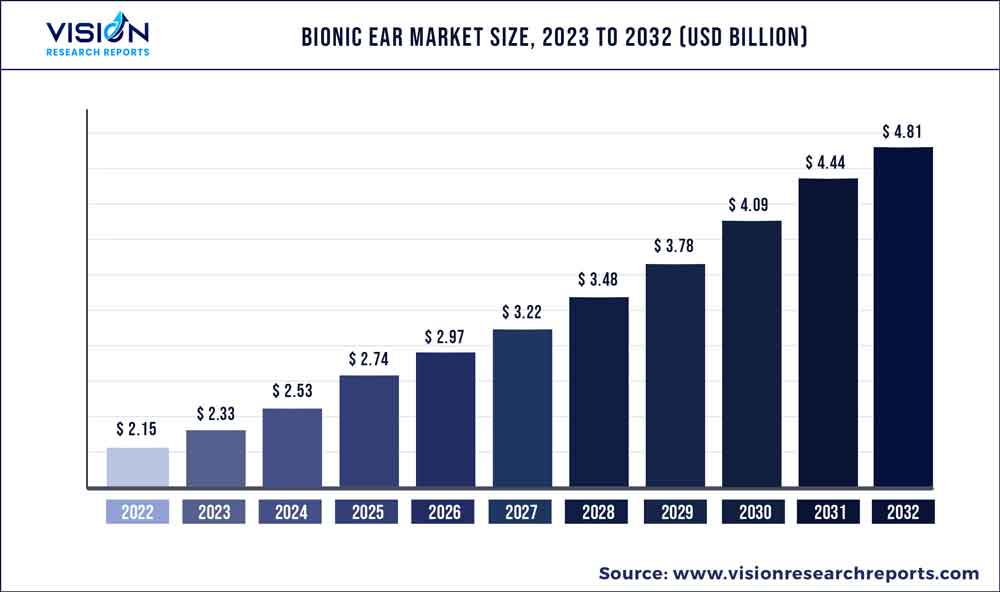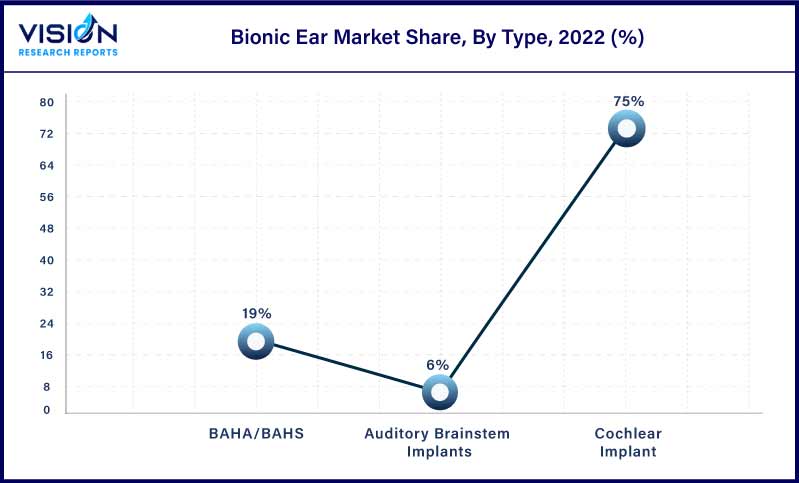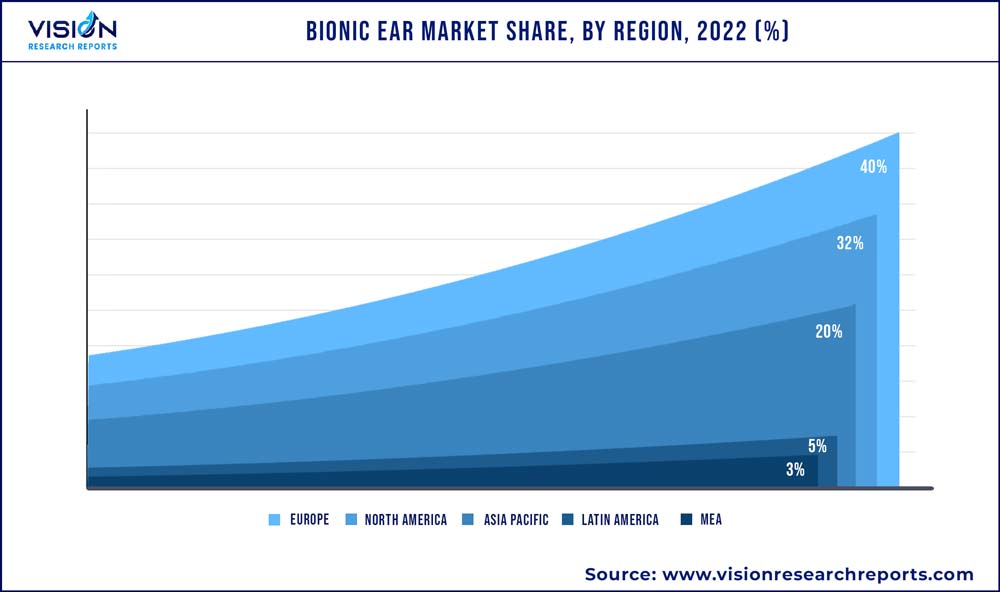The global bionic ear market was surpassed at USD 2.15 billion in 2022 and is expected to hit around USD 4.81 billion by 2032, growing at a CAGR of 8.38% from 2023 to 2032. The bionic ear market in the United States was accounted for USD 713.1 million in 2022.

Key Pointers
Report Scope of the Bionic Ear Market
| Report Coverage | Details |
| Revenue Share of Europe in 2022 | 40% |
| Revenue Forecast by 2032 | USD 4.81 billion |
| Growth Rate from 2023 to 2032 | CAGR of 8.38% |
| Base Year | 2022 |
| Forecast Period | 2023 to 2032 |
| Market Analysis (Terms Used) | Value (US$ Million/Billion) or (Volume/Units) |
| Companies Covered | Cochlear Ltd.; MED-EL Medical Electronics; Sonova; Demant A/S; Zhejiang Nurotron Biotechnology Co. Ltd.; GAES; Amplifon |
The market has been growing significantly due to the growing geriatric population, increasing prevalence of hearing loss, advancements in technology, and favorable reimbursement policies. Furthermore, there have been significant advancements in bionic ear technology over the past few years. For instance, cochlear implants now have wireless connectivity, allowing them to connect to external devices such as smartphones, televisions, and other audio equipment. This feature enables users to stream audio content directly to their cochlear implants.
Bionic ear technology has significantly improved the quality of life for people with hearing loss. In recent years, bionic ears have become smaller, more discreet, and more powerful. They could be integrated using directional microphones, internet connectivity, artificial intelligence, and hybrid technology, all of which improve user experience and sound quality. These advancements and growing awareness of various audiology devices are driving the bionic ears market growth.
According to WHO, approximately 2.5 billion people would have some kind of hearing loss and at least 700 million people are going to require hearing rehabilitation by 2050. In addition, almost 1 billion young people are at risk of permanent, preventable hearing loss because of unhealthy listening habits. High-volume speakers and exposure to loud sounds among the younger generation are also contributing to the prevalence of hearing loss. This is anticipated to drive the demand for bionic ears in the future.
The COVID-19 pandemic severely impacted the market owing to the disruption in the global supply chain and manufacturing process, affecting the availability and production of bionic ears. Many hospitals postponed elective non-urgent surgery due to a high influx of patients. Hence, many manufacturers witness a decline in their revenue. For instance, the revenue of Cochlear Ltd declined by 6.5% in 2020, as compared to 2019, due to the pandemic. Additionally, economic uncertainty and decreased consumer spending decreased the sales of bionic ear solutions.
Type Insights
The cochlear implants segment dominated the overall market with the largest revenue share of 75% in 2022. The rising number of cochlear implantation surgeries and increasing market penetration are boosting segment growth. Cochlear implants have seen significant advancements and have helped thousands of people around the world regain their hearing ability and improve their quality of life. In January 2022, Cochlear Limited announced FDA approval for Cochlear Nucleus Implants for single-sided deafness and unilateral hearing loss (UHL/SSD).

The auditory brainstem implant segment is expected to grow owing to the increasing prevalence of neurofibromatosis type 2. Over the past few years, auditory brainstem implant devices and electrode design have undergone multiple changes. Moreover, the ABI was initially developed for NF2 (Neurofibromatosis type 2) patients, new research indicates that this technology can also be used to deliver hearing in children and people who do not have tumors.
End-use Insights
Hospitals segment dominated the overall market in 2022. The segment is projected to witness the highest growth during the forecast period.Favoring health reimbursement policies in the high volume of surgeries done in hospitals are prominent factors for the dominant share of the segment. The presence of experts to perform complex cochlear, BAHA, and auditory brainstem implantations in hospitals is favoring segment growth.
Clinics segment is expected to have the second highest growth rate during the forecast period. In recent years, many clinics are offering cochlear implantation procedures to restore auditory functions in some individuals with advanced sensorineural hearing loss. (SNHL). The increasing number of well-equipped ENT clinics and the prevalence of hearing loss is augmenting the segment growth.
Regional Insights
Europe captured the highest market share of 40% in 2022. The bionic ears market growth is primarily driven by the high prevalence of hearing loss in the region, particularly among the elderly population. Additionally, advancements in bionic ear technology, increasing penetration of cochlear implants in adults and pediatrics, and increased awareness about hearing loss treatment options are contributing to the growth of the market.

Asia Pacific is projected to witness significant growth in the coming years. The region has a large and rapidly growing population, which would increase the prevalence of hearing loss. In addition, factors such as rising disposable incomes and increasing healthcare expenditure are contributing to the growth of the market. However, limited healthcare infrastructure in certain countries and the high cost of bionic ear solutions could restrict the region’s growth.
Bionic Ear Market Segmentations:
By Type
By End-use
By Regional
Chapter 1. Introduction
1.1. Research Objective
1.2. Scope of the Study
1.3. Definition
Chapter 2. Research Methodology
2.1. Research Approach
2.2. Data Sources
2.3. Assumptions & Limitations
Chapter 3. Executive Summary
3.1. Market Snapshot
Chapter 4. Market Variables and Scope
4.1. Introduction
4.2. Market Classification and Scope
4.3. Industry Value Chain Analysis
4.3.1. Raw Material Procurement Analysis
4.3.2. Sales and Distribution Channel Analysis
4.3.3. Downstream Buyer Analysis
Chapter 5. COVID 19 Impact on Bionic Ear Market
5.1. COVID-19 Landscape: Bionic Ear Industry Impact
5.2. COVID 19 - Impact Assessment for the Industry
5.3. COVID 19 Impact: Global Major Government Policy
5.4. Market Trends and Opportunities in the COVID-19 Landscape
Chapter 6. Market Dynamics Analysis and Trends
6.1. Market Dynamics
6.1.1. Market Drivers
6.1.2. Market Restraints
6.1.3. Market Opportunities
6.2. Porter’s Five Forces Analysis
6.2.1. Bargaining power of suppliers
6.2.2. Bargaining power of buyers
6.2.3. Threat of substitute
6.2.4. Threat of new entrants
6.2.5. Degree of competition
Chapter 7. Competitive Landscape
7.1.1. Company Market Share/Positioning Analysis
7.1.2. Key Strategies Adopted by Players
7.1.3. Vendor Landscape
7.1.3.1. List of Suppliers
7.1.3.2. List of Buyers
Chapter 8. Global Bionic Ear Market, By Type
8.1. Bionic Ear Market, by Type, 2023-2032
8.1.1. Cochlear Implant
8.1.1.1. Market Revenue and Forecast (2020-2032)
8.1.2. Auditory Brainstem Implants
8.1.2.1. Market Revenue and Forecast (2020-2032)
8.1.3. BAHA/BAHS
8.1.3.1. Market Revenue and Forecast (2020-2032)
Chapter 9. Global Bionic Ear Market, By End-use
9.1. Bionic Ear Market, by End-use, 2023-2032
9.1.1. Hospitals
9.1.1.1. Market Revenue and Forecast (2020-2032)
9.1.2. Clinics
9.1.2.1. Market Revenue and Forecast (2020-2032)
9.1.3. Others
9.1.3.1. Market Revenue and Forecast (2020-2032)
Chapter 10. Global Bionic Ear Market, Regional Estimates and Trend Forecast
10.1. North America
10.1.1. Market Revenue and Forecast, by Type (2020-2032)
10.1.2. Market Revenue and Forecast, by End-use (2020-2032)
10.1.3. U.S.
10.1.3.1. Market Revenue and Forecast, by Type (2020-2032)
10.1.3.2. Market Revenue and Forecast, by End-use (2020-2032)
10.1.4. Rest of North America
10.1.4.1. Market Revenue and Forecast, by Type (2020-2032)
10.1.4.2. Market Revenue and Forecast, by End-use (2020-2032)
10.2. Europe
10.2.1. Market Revenue and Forecast, by Type (2020-2032)
10.2.2. Market Revenue and Forecast, by End-use (2020-2032)
10.2.3. UK
10.2.3.1. Market Revenue and Forecast, by Type (2020-2032)
10.2.3.2. Market Revenue and Forecast, by End-use (2020-2032)
10.2.4. Germany
10.2.4.1. Market Revenue and Forecast, by Type (2020-2032)
10.2.4.2. Market Revenue and Forecast, by End-use (2020-2032)
10.2.5. France
10.2.5.1. Market Revenue and Forecast, by Type (2020-2032)
10.2.5.2. Market Revenue and Forecast, by End-use (2020-2032)
10.2.6. Rest of Europe
10.2.6.1. Market Revenue and Forecast, by Type (2020-2032)
10.2.6.2. Market Revenue and Forecast, by End-use (2020-2032)
10.3. APAC
10.3.1. Market Revenue and Forecast, by Type (2020-2032)
10.3.2. Market Revenue and Forecast, by End-use (2020-2032)
10.3.3. India
10.3.3.1. Market Revenue and Forecast, by Type (2020-2032)
10.3.3.2. Market Revenue and Forecast, by End-use (2020-2032)
10.3.4. China
10.3.4.1. Market Revenue and Forecast, by Type (2020-2032)
10.3.4.2. Market Revenue and Forecast, by End-use (2020-2032)
10.3.5. Japan
10.3.5.1. Market Revenue and Forecast, by Type (2020-2032)
10.3.5.2. Market Revenue and Forecast, by End-use (2020-2032)
10.3.6. Rest of APAC
10.3.6.1. Market Revenue and Forecast, by Type (2020-2032)
10.3.6.2. Market Revenue and Forecast, by End-use (2020-2032)
10.4. MEA
10.4.1. Market Revenue and Forecast, by Type (2020-2032)
10.4.2. Market Revenue and Forecast, by End-use (2020-2032)
10.4.3. GCC
10.4.3.1. Market Revenue and Forecast, by Type (2020-2032)
10.4.3.2. Market Revenue and Forecast, by End-use (2020-2032)
10.4.4. North Africa
10.4.4.1. Market Revenue and Forecast, by Type (2020-2032)
10.4.4.2. Market Revenue and Forecast, by End-use (2020-2032)
10.4.5. South Africa
10.4.5.1. Market Revenue and Forecast, by Type (2020-2032)
10.4.5.2. Market Revenue and Forecast, by End-use (2020-2032)
10.4.6. Rest of MEA
10.4.6.1. Market Revenue and Forecast, by Type (2020-2032)
10.4.6.2. Market Revenue and Forecast, by End-use (2020-2032)
10.5. Latin America
10.5.1. Market Revenue and Forecast, by Type (2020-2032)
10.5.2. Market Revenue and Forecast, by End-use (2020-2032)
10.5.3. Brazil
10.5.3.1. Market Revenue and Forecast, by Type (2020-2032)
10.5.3.2. Market Revenue and Forecast, by End-use (2020-2032)
10.5.4. Rest of LATAM
10.5.4.1. Market Revenue and Forecast, by Type (2020-2032)
10.5.4.2. Market Revenue and Forecast, by End-use (2020-2032)
Chapter 11. Company Profiles
11.1. Cochlear Ltd.
11.1.1. Company Overview
11.1.2. Product Offerings
11.1.3. Financial Performance
11.1.4. Recent Initiatives
11.2. MED-EL Medical Electronics
11.2.1. Company Overview
11.2.2. Product Offerings
11.2.3. Financial Performance
11.2.4. Recent Initiatives
11.3. Sonova
11.3.1. Company Overview
11.3.2. Product Offerings
11.3.3. Financial Performance
11.3.4. Recent Initiatives
11.4. Demant A/S
11.4.1. Company Overview
11.4.2. Product Offerings
11.4.3. Financial Performance
11.4.4. LTE Scientific
11.5. Zhejiang Nurotron Biotechnology Co. Ltd.
11.5.1. Company Overview
11.5.2. Product Offerings
11.5.3. Financial Performance
11.5.4. Recent Initiatives
11.6. GAES
11.6.1. Company Overview
11.6.2. Product Offerings
11.6.3. Financial Performance
11.6.4. Recent Initiatives
11.7. Amplifon
11.7.1. Company Overview
11.7.2. Product Offerings
11.7.3. Financial Performance
11.7.4. Recent Initiatives
Chapter 12. Research Methodology
12.1. Primary Research
12.2. Secondary Research
12.3. Assumptions
Chapter 13. Appendix
13.1. About Us
13.2. Glossary of Terms
 Cross-segment Market Size and Analysis for
Mentioned Segments
Cross-segment Market Size and Analysis for
Mentioned Segments
 Additional Company Profiles (Upto 5 With No Cost)
Additional Company Profiles (Upto 5 With No Cost)
 Additional Countries (Apart From Mentioned Countries)
Additional Countries (Apart From Mentioned Countries)
 Country/Region-specific Report
Country/Region-specific Report
 Go To Market Strategy
Go To Market Strategy
 Region Specific Market Dynamics
Region Specific Market Dynamics Region Level Market Share
Region Level Market Share Import Export Analysis
Import Export Analysis Production Analysis
Production Analysis Others
Others